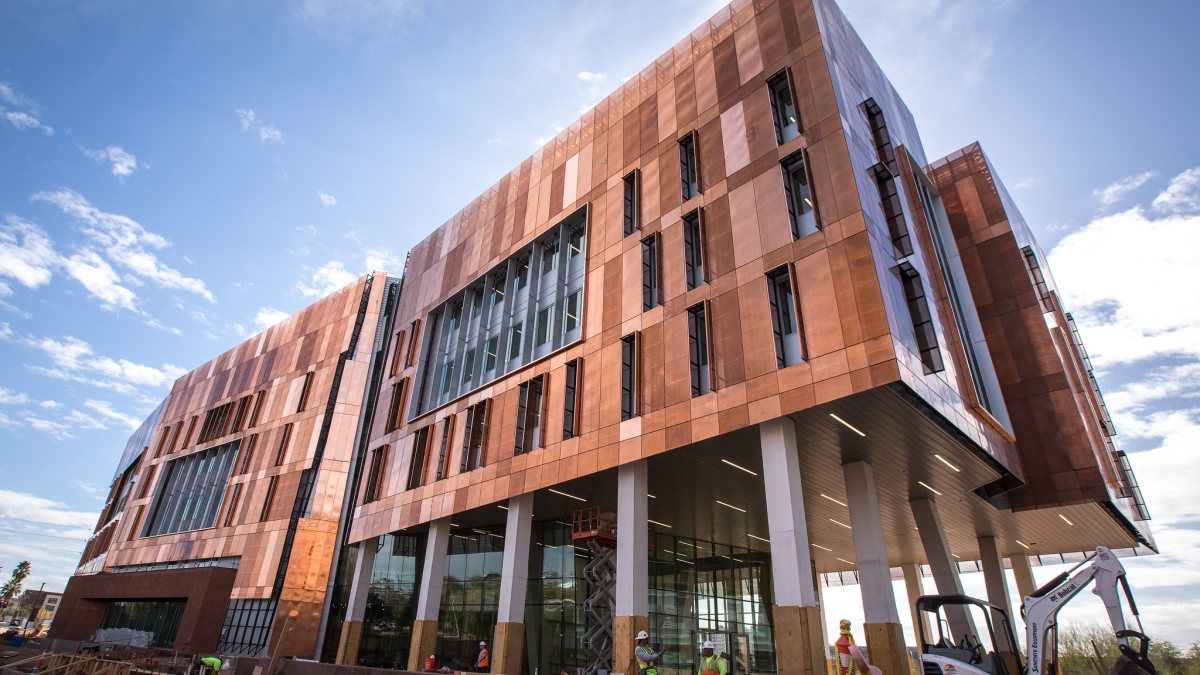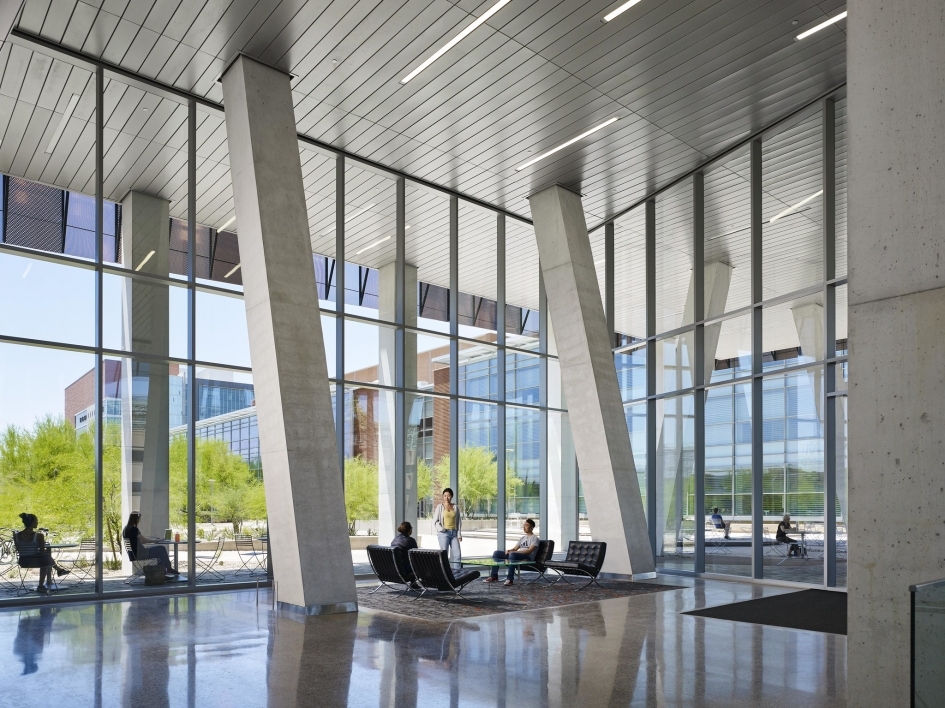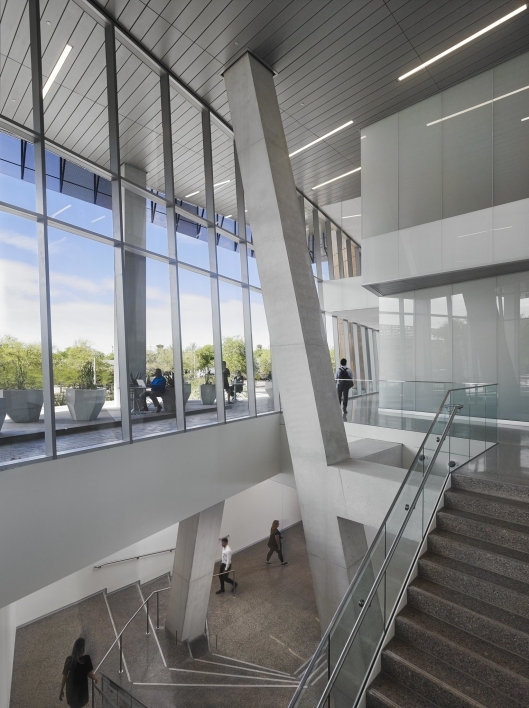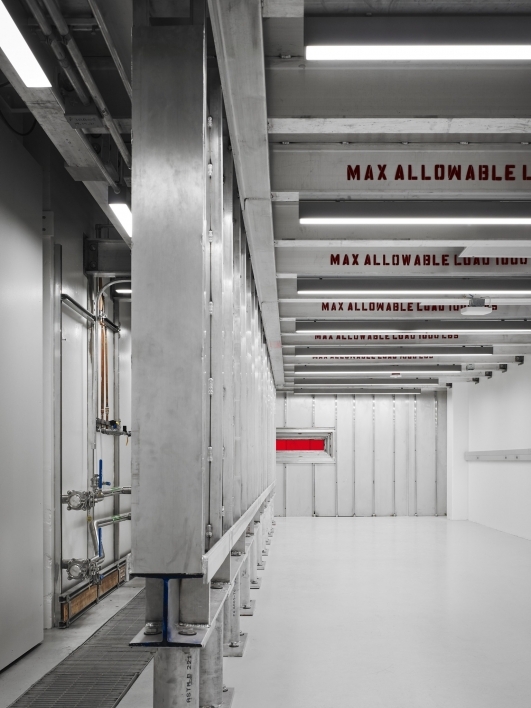Biodesign C shines in 'Copper' awards

Copper glory: Biodesign C in the final stages of construction. Photo by Nick Merrick, Hall+Merrick/ZGF Architects
Traveling down Rural Road next to Arizona State University’s Tempe campus, it’s impossible to ignore the shiny copper façade of the Biodesign Institute Building C.
The building earned another accolade as a modern-day architectural marvel with its latest win, a North American Copper in Architecture Award. Turns out, this shiny reddish metal is very green — as a sustainable building material — and has a very long history.
Some of the most celebrated landmarks in the world’s history featured copper. The massive doors of the temple Amen-Re at Karnak in ancient Egypt were clad in the semiprecious metal. The “Golden Temple” built during the Ming Dynasty in Kunming, China, was solid copper, not gold. From the spires and roofs of celebrated castles and cathedrals of Europe, along with the famous baptistry doors of Italy’s Florence Cathedral, copper endures as a timeless element. One of America’s greatest landmarks, the Statue of Liberty, is coated in copper, the same thickness as putting two pennies together.
Likewise, Biodesign Institute C is an award-winning landmark on ASU’s Tempe campus. It won the 2019 North American Copper in Architecture Award granted by the Copper Development Association and the Canadian Copper and Brass Development Association. The awards program recognizes and promotes building projects in the United States and Canada for their outstanding use of architectural copper and copper alloys. ASU’s building was one of 15 to earn the distinction.
“The distinctive copper exterior is a nod to Arizona’s roots, copper being one of Arizona’s historic 'Five Cs' that drove the state’s early economy, and is a unique expression of the reddish hue that permeates the campus architecture,” said designer Sean McGreal, lead principal with ZGF Architects. “From the earliest stages of conceptualization, the design intention was to enclose the building in copper to create a visually stunning and highly functional outer skin for the building’s double skin system.”
As part of the building’s high-performance double skin façade, an outer copper screen wraps around a primary skin of insulated metal panels.
“The screen is comprised of thousands of copper panels featuring eight different levels of perforation,” McGreal said. “These perforation patterns have been carefully calibrated and positioned to minimize solar heat gain, optimize daylighting and visual comfort, and provide unobstructed views of the campus.”
Separately, the building’s outer copper screen and primary skin of insulated metal panels don’t reduce energy usage, but together they deliver remarkable cooling benefits.
A two-foot gap between the insulated metal panels and copper screen, coupled with openings in the screen, creates a ventilated cavity where the air temperature between the two skins is balanced with the outdoor air temperature. The copper screen acts as a shading device that reduces the surface temperature of the inner façade by roughly 65 degrees on hot summer days. In turn, the shade reduces the interior surface temperature of the building’s walls, significantly reducing the cooling load on perimeter spaces.
Beyond the energy-saving use of copper in the building’s façade design, the metal alone is environmentally friendly. “Copper is truly one of the most versatile and sustainable building materials available,” said Stephen Knapp, a director with the Copper Development Association.
Copper boasts one of the highest recycling rates of any engineering material. Copper roofing or cladding isn’t discarded and doesn’t wind up in landfills; because of its value, it can be easily salvaged and recycled.
It is also highly durable and requires little or no maintenance. Copper’s longevity is due to a natural patina it develops with age, weathering naturally to a lovely blue-green or nut brown color depending on climate. Unlike rust oxidation, the copper patina is a protective barrier that retards further corrosion, maintaining copper’s long life.
“As the green building trend continues, we expect to see the material increasingly utilized to achieve various certifications and environmental goals,” Knapp said.
Among Biodesign Institute C’s other accolades, the U.S. Green Building Council awarded the facility the prestigious LEED platinum certification. Biodesign C is the fifth ASU building to receive a platinum certification, the highest green building ranking under the U.S. Green Building Council’s LEED — Leadership in Energy and Environmental Design — program, which recognizes buildings that are designed and constructed for high standards of energy efficiency and sustainability.
"Building C is unique on so many levels,” said Biodesign Executive Director Joshua LaBaer. “Its design and construction, including the sleek copper façade, really reflect the ideals of the institute itself, where so many innovative and interdisciplinary approaches to science are unfolding. This award is further testament to that.”
In addition, Engineering News Record, a publication focusing on engineering and construction news, designated the building as a national Best of the Best Project in the Higher Education/Research category. Approximately 200 projects across America were considered for the honor.
Biodesign Institute C houses critical lab and research support space designed to accelerate ASU scientific research and enable the creation of cutting-edge, collaborative research clusters. The building will be home to the first-of-its-kind compact X-ray free electron laser.
From the outset, aspirations for the building’s design were set very high. A goal was to create a new research building that provided highly flexible and adaptable space for reliable research. ASU challenged the design team to create a dense web of workspace options that would promote and empower the formation of collaborative research clusters, while increasing opportunities for chance interactions among different research groups.
“Our research at ASU is growing all the time, and I believe a big draw for researchers is Biodesign Institute C,” said Monica Perrin, ASU Capital Programs senior project manager. “I’ve spoken to researchers, and they love the fact that it’s a collaborative space, they enjoy the environment, and the design helps them to be successful in their research.”
Written by Lori Baker
More Science and technology

Study reveals genetic insight into desert survival
The deserts of the American Southwest are home to the Mojave and Sonoran desert tortoises, two seemingly similar yet genetically…

Study reveals lasting effects of common weed killer on brain health
Environmental exposure to toxins in the air, water or certain chemicals can increase the risk of ill health effects, including to…

ASU grad to use science to get an edge on crime
Editor’s note: This story is part of a series of profiles of notable fall 2024 graduates.As a child growing up in Pinetop,…


